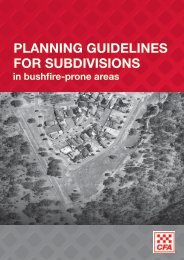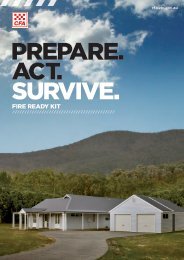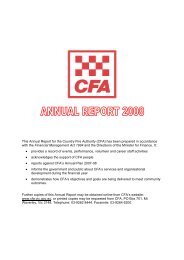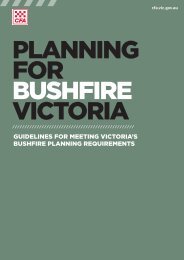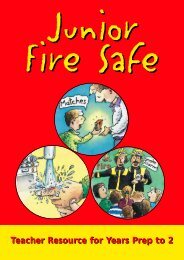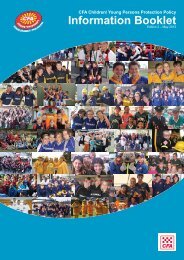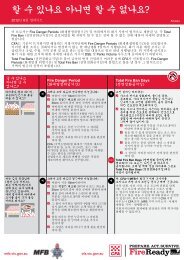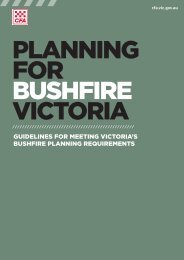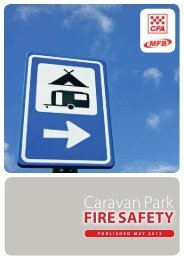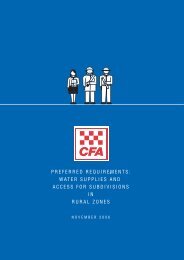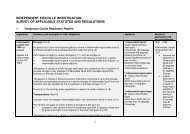Training Specifications and Guidelines - Country Fire Authority
Training Specifications and Guidelines - Country Fire Authority
Training Specifications and Guidelines - Country Fire Authority
Create successful ePaper yourself
Turn your PDF publications into a flip-book with our unique Google optimized e-Paper software.
Forest Industry Brigade<br />
<strong>Training</strong> Specification <strong>and</strong> <strong>Guidelines</strong><br />
LEARNING MATERIALS GUIDE<br />
Introduction<br />
This guide has been developed as an aid to identify:<br />
the subjects that are encompassed by a particular FIB role;<br />
the subject description;<br />
what it is you will need to know <strong>and</strong>/or be able to demonstrate about the subject to achieve skills<br />
recognition; <strong>and</strong><br />
what learning materials <strong>and</strong> information you will need to access to assist in underst<strong>and</strong>ing or<br />
revising the subject.<br />
Copies of learning manuals <strong>and</strong> other reference materials are available from your brigade. Contact your<br />
training officer to gain access to these materials.<br />
NON FIB MEMBERS<br />
All non FIB members used by the FIB (for example; plant operators) who may be required to enter the<br />
fireground must successfully complete a CFA “Maintain safety at an incident scene” program. In<br />
addition given the nature of the potential risks <strong>and</strong> operating environment for FIB contractors the<br />
following additional content must be included in the “Maintain safety at an incident scene” program.<br />
Basic Wildfire Behaviour<br />
Subject<br />
Description<br />
Describe how materials<br />
burn<br />
Identify the basic factors<br />
which affect fire<br />
behaviour<br />
Describe the<br />
development of wildfires<br />
Describe <strong>and</strong><br />
demonstrate basic fire<br />
suppression strategies<br />
<strong>and</strong> tactics<br />
Describe the risks <strong>and</strong><br />
hazards of firefighting<br />
<strong>and</strong> the precautions to be<br />
taken<br />
What you need to know or be able to demonstrate<br />
Knowledge<br />
Identify the elements required for a fire to exist; <strong>and</strong><br />
describe one common method to control each of these elements.<br />
List the three groups of factors that affect fire behaviour;<br />
describe the relationship between wind speed <strong>and</strong> direction, <strong>and</strong> the shape of a<br />
fire; <strong>and</strong> describe the effect of slope on fire behaviour.<br />
Explain the terms origin, head, flank <strong>and</strong> rate of spread;<br />
describe <strong>and</strong> contrast a ground, surface <strong>and</strong> crown fire; <strong>and</strong><br />
describe spotting, <strong>and</strong> its causes <strong>and</strong> effect on fire behaviour.<br />
Explain the differences between a “direct attack” (including parallel attack), <strong>and</strong><br />
“indirect attack”;<br />
explain the term “defensive firefighting” <strong>and</strong> give an example of its use;<br />
explain the difference between a head attack <strong>and</strong> a flank attack;<br />
explain what is meant by a “mineral earth break” <strong>and</strong> demonstrate how to<br />
construct one with a h<strong>and</strong>tool;<br />
demonstrate the correct use of a knapsack pump; <strong>and</strong> explain the meaning of<br />
the terms “fire suppression” <strong>and</strong> “mop-up”.<br />
Identify <strong>and</strong> describe the principal hazards, including the main risky wildfire<br />
scenarios, <strong>and</strong> precautions involved in wildfire firefighting;<br />
describe the use of potential fire shelters, including motor vehicles, in life<br />
threatening situations;<br />
identify the problems associated with insufficient water intake, food intake <strong>and</strong><br />
rest breaks, <strong>and</strong> inappropriate food intake;<br />
describe how to avoid, recognise <strong>and</strong> treat heat related illness;<br />
explain the purpose <strong>and</strong> limitations of protective clothing <strong>and</strong> equipment;<br />
explain why it is necessary to work as a team <strong>and</strong> the steps to be taken if there<br />
Edition 2,<br />
May 2008 Safety First Page 10



